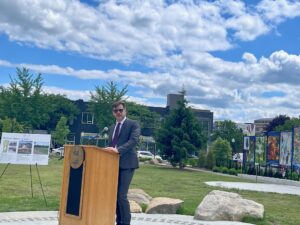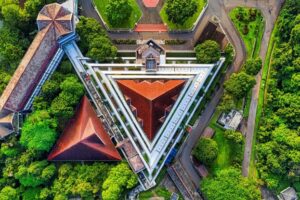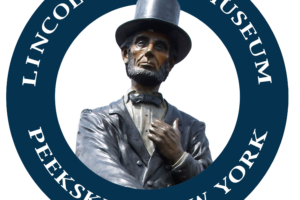
Whether those dollars actually prove the spur to economic development — or fail to produce new housing, retail shopping and vitality in the downtown — is a question to be answered over the next five years.
“Momentum” and “DRI” are two New York state grant programs that could play a major role in bringing to life a grand vision of Peekskill.
Under a Cuomo-era grant program called Downtown Revitalization Initiative (DRI), Peekskill was awarded $10 million in 2019 to pick the projects that local residents wanted to fund.
After a two-year process delayed by the pandemic, the projects funded by that grant were announced. The largest grants were: $1.6 million to create a downtown civic hub; $1.6 million to the former Worker’s Compensation Board building to include a Peekskill Arts Center; $1.5 million for a proposed Boys & Girls Club at the Kiley Center; $1.1 million to connect cyclists and pedestrians between the waterfront and downtown; and $1 million to revitalize the Paramount Hudson Valley Theater.
***
The most recent results are the re-opening of Pugsley Park and displays of public art. None of the big-ticket items have been completed and several are being revised.
Now the city has been awarded an additional $10 million in state “seed money” by winning a Mid-Hudson Momentum Fund grant announced by Gov. Kathy Hochul on May 29.
The Mid-Hudson Momentum Fund grant program requires that the winning bidders provide a 50% match to the state money. Peekskill plans on raising another $10 million through the city’s capital account, bonding, remediation funds, parking revenue and developer fees, and has set an aggressive target date of two years to complete the projects.
The city’s original $20 million Momentum Fund preliminary spending plan called for $12.76 million to build new garage parking space, $2.2 million to renovate the Nelson Garage and $350,000 at the James Street Garage. A new parking garage next to the one on James Street is high on the list.

Another $1.75 million was targeted for streetscape improvements, along with $1.3 million in park improvements. Development along Railroad Avenue will require roadway elevation to meet FEMA [Federal Emergency Management Agency] standards and sewer line upgrades, so $1.64 million was budgeted for those improvements.
***
Now that the grant has been awarded, the hard work of holding discussions with developers begins to help decide where the spending will have the most impact and who’s willing to pay to help.
Peekskill City Manager Matt Alexander and Director of Planning Carol Samol have the task of bringing lots of moving parts into motion. It won’t be easy.
“It’s now up to the Common Council and city staff to come up with a solution to housing affordability, economic development and revitalization all in one hit,” Alexander tells River Journal. “Those are three big challenges for the city of Peekskill that we need to address.”
With nearly 500 units of housing under construction or in the planning approval stage, Peekskill is already off to a good start. The potential for another 500 units or more exists, and developers have Peekskill in their sights. Adding 1,000 new households with an average annual income of $100,000 would bring upwards of tens of millions of dollars a year to Peekskill’s economy. (The median household income in Peekskill in 2022 was $81,774, according to City-Data.com.)
“It’s a lot of different developers to make deals with,” Alexander says. “It’s hard enough to make a deal with just one developer, but it’s nice that we now have the incentives to offer.”
***
Decisions on where to spend infrastructure money will depend on producing the highest number of new housing units.
“We’ll be making some significant investments in specific locations,” Samol said. “It could be looking at parking and streetscape in the downtown, building on the DRI work, or sewer and resiliency on the waterfront.
“The locational advantage of the improvements will help some projects and not others, but all the projects build on one another for affordability and economic development and for the betterment of the citizens of Peekskill.”
Separately, the city is now considering development ideas from six or seven bidders for under-utilized municipal parking lots on the riverfront. Several smaller city-owned parking lots could also be in play for development.
Bill Balter, who built the 82-unit affordable housing project at 645 Main Street that opened last year, said that without getting infrastructure dollars to subsidize the parking and other infrastructure, projects today are unfeasible.
The primary focus for the Momentum money will be parking — rehabbing the city’s two existing municipal lots and building new parking to house residents in new buildings.
“All sorts of plans are ready to go for a mixed-use building, but the parking has always been an issue,” said Louie Lanza, who heads a group that wants to redevelop the former Worker’s Compensation building at 41 N. Division Street. “This grant could definitely ease that problem.”
***
[However, at press time, developers were presenting a plan to develop low-income housing for non-profit The Children’s Village at the Worker’s Compensation Board building, possibly taking the property off city tax rolls and reducing the amount of economic development of the site.]

Two other projects that would benefit by adding parking in the downtown are at Broad and Howard (Chuck Lesnick) and 201 N. Division (James Guerriero).
“The Momentum Fund and [New York State’s] Empire State Development in general are providing lifelines to projects that would otherwise be impossible in the current market,” Guerriero said. “The amount and timeline are equally impressive. The mayor, council, and city staff clearly understand that the need is now.
“Thanks to their efforts, these critical infrastructure upgrades will support new multifamily housing starts which will ease the burden felt by so many Peekskill residents.”
Lesnick said his project will help feed the momentum Peekskill is seeking in the downtown district. “The more housing units are built, the greater demand for commercial and retail, and the greater selection of retail options you have, the more attractive it is for more people to want to move here.”
Businesses in the downtown are optimistic that the infrastructure investments will benefit them in the future.
***
“We congratulate the City of Peekskill for pursuing and receiving $10 million in funding from the Mid-Hudson Momentum Fund to make critical infrastructure improvements, while helping to address the housing shortage in our area,” said Bill Powers, Executive Director of the Peekskill Business Improvement District (BID).
“We also applaud the city’s efforts to leverage those funds to make additional investments in parking structures and other improvements, which will enhance the visitor and residential experience as they patronize downtown restaurants, shops, and business services.”
Martin Ginsburg, the principal of Ginsburg Development Corp., said in a city video, “We think Peekskill is at a critical junction right now. We would be willing to invest a lot more if Peekskill gets substantial financial support.”
Ginsburg owns the property along Railroad Avenue. After being rebuffed by the Common Council last year, he is expected to come back with a new proposal.
Another project that could benefit from Momentum infrastructure money is a proposal by developer Ken Kearney to build 200 units of affordable housing on Lower South Street at the former Karta recycling site. A main sewer line that runs through the property has to be relocated before construction could begin.
Jim Roberts is a veteran journalist and third-generation Peekskill resident.







Can we put a glass siding over the monster ugly building the wheelabrator ? Glass siding reflects the river mountains and trees. Or just get rid of it and put nice parks and restaurants along the walk?